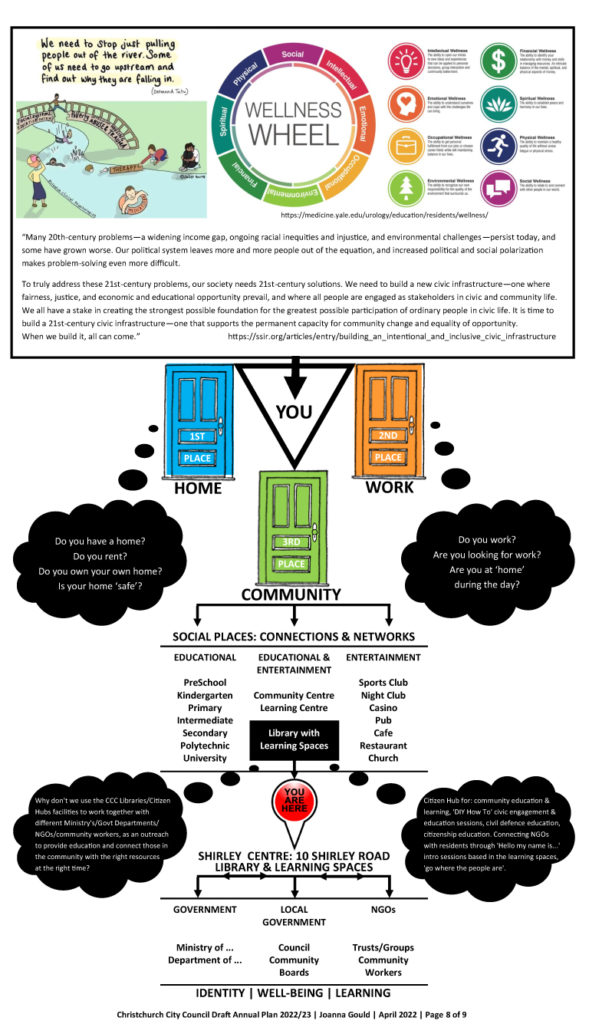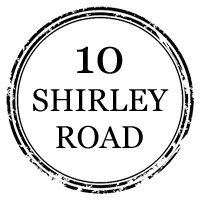“Review into the Future for Local Government”
https://www.futureforlocalgovernment.govt.nz/
“Review into the Future for Local Government”: Interim Report
https://www.futureforlocalgovernment.govt.nz/assets/Uploads/DIA_16724_Te-Arotake-Future-of-Local-Government_Interim-report_22.pdf
The wellbeing dimension (Page 17-24)
“The future wellbeing of New Zealand communities depends at least in part on effective local governance. Under the Local Government Act 2002, one of the purposes of local government is to promote social, economic, environmental and cultural wellbeing in local communities.
This review is being conducted to determine how local authorities might need to evolve in order to deliver on that purpose over the next 30 years.
Under current local governance arrangements, local authorities make significant contributions to local wellbeing, but neither they nor central government on their own can address the most significant wellbeing issues facing local communities, or to address all of the challenges that might emerge in the future.
A more collaborative approach will be necessary in future to meet these challenges and create conditions in which communities can thrive over the next three decades.
The vast bulk of local government spending is focused on infrastructure, the environment, and facilities and services – including…facilities such as libraries, and community and recreation centres.
These facilities and services play critical roles in local wellbeing. They provide for basic needs; keep people healthy and safe; allow people to move around and connect with each other; enable work and business activity; support family, neighbourhood and community connections; and create environments in which people can exercise and relax. An attractive, well-functioning physical and natural environment can lift mood, reflect identity, create a sense of belonging, and attract skills, tourism and commerce.”
LIANZA “Libraries and the Future of Local Government Review Panel”
https://www.youtube.com/watch?v=ViiMtWcPlys
Below is my email to the “Review into the Future for Local Government” Panel:
Hi
Last night I watched the LIANZA “Libraries and the Future of Local Government” public panel discussion & listened to Gael Surgenor speak about the review.
https://www.librariesaotearoa.org.nz/korero-blog/library-and-the-future-of-local-government-review-panel-27-june
Below is an overview of my “Learning Libraries” concept (Library with Learning Spaces: Community Education & Support Services):
https://www.10shirleyroad.org.nz/shirley-centre-concept-image/

“In community building, the third place is the social surroundings separate from the two usual social environments of home (“first place”) and the workplace (“second place”).
Examples of third places would be environments such as churches, cafes, clubs, public libraries, bookstores or parks. https://en.wikipedia.org/wiki/Third_place
In his influential book The Great Good Place, Ray Oldenburg (1989, 1991) argues that third places are important for civil society, democracy, civic engagement, and establishing feelings of a sense of place.
Third places, then, are “anchors” of community life and facilitate and foster broader, more creative interaction.”
We have many in our communities who don’t have a ‘second place (work)’: stay at home parents, caregivers, retirees, unemployed, people unable to work due to chronic illness, people working from home etc.
Some due to their circumstances don’t feel like they have a safe and relaxing ‘first place (home)’.
This is why it is so important that our ‘third places (social)’ are welcoming, inclusive & accessible for everyone in our communities.
“Urban planners seeking to stabilize neighborhoods are focusing on the critical role that “third places” can play in strengthening our sense of community.
Third places have a number of important community-building attributes.
Depending on their location, social classes and backgrounds can be “leveled-out” in ways that are unfortunately rare these days, with people feeling they are treated as social equals.
Informal conversation is the main activity and most important linking function. One commentator refers to third places as the “living room” of society.
Many city planning efforts to reinvigorate metropolitan neighborhoods now include specific steps to create third places, especially public spaces, to try and break down social siloes.”
https://www.brookings.edu/blog/up-front/2016/09/14/third-places-as-community-builders
“The public library is the one place, potentially the only civic place, where people are welcome to come no matter their background, their politics, their beliefs.
People who are disenfranchised, have mobility issues, are socially isolated, the very old and the very young, it can be the only comfortable place to be – and their ideas are welcome.”
“We are becoming a bastion of wellbeing and welcome for people,” says Kat Cuttriss, Hutt City Libraries manager and chair of Public Libraries of New Zealand.
https://www.stuff.co.nz/entertainment/books/113926856/how-new-zealand-libraries-are-adapting-to-the-21st-century
“Social infrastructure provides the setting and context for social participation, and the library is among the most critical forms of social infrastructure that we have.
It’s also one of the most undervalued…Our communities are full of children whose future, will be formed in the places where they go to learn about themselves and the world they’ll inherit. They deserve palaces. Whether they get them is up to us.”
“Palaces for the People: How To Build a More Equal and United Society” by Eric Klinenberg
https://www.theguardian.com/cities/2018/sep/24/palaces-for-the-people-at-the-library-everyone-is-welcome
“Tangata ako ana i te kāenga, te tūranga ki te marae, tau ana.
A person nurtured in the community contributes strongly to society.”
When we know who we are (identity), what we need to be healthy (well-being), and the importance of a growth mindset (learning), this causes a positive ripple effect in our businesses, communities and economy.
“Inā kei te mohio koe ko wai koe, I anga mai koe i hea, kei te mohio koe. Kei te anga atu ki hea.
If you know who you are and where you are from, then you will know where you are going.”
– https://www.10shirleyroad.org.nz/wp-content/uploads/2020/04/CCCDraftAnnualPlan2020JoannaGould.pdf
Page 3-5: Canterbury Wellbeing Index
Page 6: Original Learning Libraries Concept
The Christchurch City Council has set the bar high on how to create architectural award winning libraries & community centres.
What if Christchurch City Council also set the example for what happens inside?
What happens inside the library has more impact on our communities. How?
By creating Learning Libraries: citizen hubs where community education is the centre & the learning spaces are utilised by the Govt/CCC/Organisations as a central outreach to the residents in the surrounding communities.
Learning Libraries are ‘schools in the community for everyone, all ages & stages of life are welcome.’
– https://www.10shirleyroad.org.nz/learning-libraries-concept/
Instore demonstrations work with the flow of people in a supermarket & are positioned accordingly. Shoppers usually have one of three reactions:
1. Participate (stop & engage with demonstrator),
2. Engage (walk passed & take what is handed to them by the demonstrator),
3. Observe (watches & listens by shelves close to the demonstrator)
The same principles would work if we integrated support services into our library learning spaces:
1. Participate: support services can invite residents to learn more about their services or hold weekly/monthly meetings.
2. Engage: support services ‘demonstrators’ become a familiar face, in residents local ‘safe’ place, more accessible ‘bumping’ space.
3. Observe: residents are now aware of this support service, they might not need their help at this time or they might remember this support services & refer someone else to it.
Residents might not be comfortable approaching ‘demonstrators’ in a public place & may reach out to the support service in private.
Some residents who have trust issues, will need to see the support service or ‘demonstrator’ more than once, before they decide it is ‘safe’ to ‘participate’ or ‘engage’.
– https://www.10shirleyroad.org.nz/instore-demonstration-concept/
– https://www.10shirleyroad.org.nz/community-education/
If “Reading is the gateway skill that makes all other learning possible.” (Barack Obama), why is it so hard for people who struggle to read, to get the help & support they need?
There are tools available (like the different coloured plastic in this video), so why aren’t we sharing this knowledge in our Christchurch City Libraries?
https://fb.watch/dXA5h3M_WF/
– https://www.10shirleyroad.org.nz/support-services/
“The accessible physical space of the library is not the only factor that makes it work well as social infrastructure.
The institution’s extensive programming, organized by a professional staff that upholds a principled commitment to openness and inclusivity, fosters social cohesion among clients who might otherwise keep to themselves…
Why have so many public officials and civic leaders failed to recognize the value of libraries and their role in our social infrastructure?
Perhaps it’s because the founding principle behind the library—that all people deserve free, open access to our shared culture and heritage, which they can use to any end they see fit—is out of sync with the market logic that dominates our time…
Their core mission is to help people elevate themselves and improve their situation. Libraries do this, principally, by providing free access to the widest possible variety of cultural materials to people of all ages, from all ethnicities and groups.”
“Palaces for the People: How To Build a More Equal and United Society” by Eric Klinenberg
Libraries are usually the first place new people to an area will go to for information/help, as they are often centrally located in our communities & accessible by public transport.
Our librarians are information specialists. They are often the first public servant our babies meet & our children grow up knowing that it’s ok to ask a librarian for help.
I’ve been advocating since 2018 for a new building to be built on 10 Shirley Road, after our former Shirley Primary School/Shirley Community Centre was demolished in 2012 due to earthquake damage.
– https://www.10shirleyroad.org.nz/
– https://www.10shirleyroad.org.nz/where-is-our-community-centre-petition/
– https://www.10shirleyroad.org.nz/poto-williams-support-letter/
– https://www.10shirleyroad.org.nz/duncan-webb-support-letter/
The former Shirley Community Centre was a historic building, used for Cultural, Educational and Recreational Activities.
Prior to the September 4, 2010, and February 22, 2011 earthquakes, the well-established centre was used by many community groups.
The Shirley Library (built in 1995), has become our community centre by default & is located in the carpark of The Palms mall (Burwood Ward).
The building is smaller than most ‘suburban’ libraries in Christchurch, with the Shirley Library, Service Centre/NZ Post & Coastal-Burwood Governance unit sharing this space.
– https://www.10shirleyroad.org.nz/wp-content/uploads/2021/04/RichmondResearchJoannaGould.pdf
Page 1-2: Identity, Well-being, Learning, Shirley Library & 10 Shirley Road
– https://www.10shirleyroad.org.nz/shirley-centre-overview/
– https://www.10shirleyroad.org.nz/design-considerations/
– https://www.10shirleyroad.org.nz/wp-content/uploads/2022/05/ShirleyCentreConcept2021JoannaGould.pdf
There is no suburban library in the Innes Ward. The ward boundary size will decrease in the October 2022 elections, due to the population increase in social housing & infill housing in these areas.
– https://www.10shirleyroad.org.nz/wp-content/uploads/2022/04/CCCDraftAnnualPlan2022JoannaGould.pdf
Page 6, ReVision Youth Audit Shirley Library
Shirley Library is still considered the second busiest suburban library in Christchurch, even without dedicated learning spaces (limited after school/holiday programmes) & meeting rooms.
“It [South] is the third-busiest suburban library, behind Fendalton and Shirley, with 4552 weekly visitors.”
– https://i.stuff.co.nz/the-press/news/128047707/earthquake-repairs-spell-18month-closure-of-popular-christchurch-library
From a potential disaster/civil defence point of view, a standalone civic building at 10 Shirley Road, opposite our largest school (Shirley Primary) would also provide a central emergency location (with solar panels & rainwater harvesting system).
The Palms was closed for over six months due to earthquake repairs. Fences and containers at Shirley Library: https://canterburystories.nz/collections/community/ginahubert/ccl-cs-22611
– https://hauora.co.nz/assets/files/Resources/Final%20Report%20to%20HRC%20-%20Building%20Community%20Resilience.pdf
“Building Community Resilience: Learning from the Canterbury earthquakes”, Appendix 2: Shirley Case Study Report, Page 73-85
– https://www.10shirleyroad.org.nz/south-library-report/
The communities around Shirley Road have been waiting since 2012 for a new building to be built on 10 Shirley Road.
Why has the Christchurch City Council deferred funding this until 2030/31?
Please let me know if you have any questions,
Joanna Gould
https://www.facebook.com/ShirleyCentre10ShirleyRoad/
(updated daily with research/ideas/organisations/shared posts)
P.S. I forgot to sending this link in my email, to my Shirley Centre research from 2019, on why a new building at 10 Shirley Road is important, a need not a want:
https://www.10shirleyroad.org.nz/wp-content/uploads/2022/07/ShirleyCentreResearch2019JoannaGould.pdf
